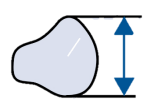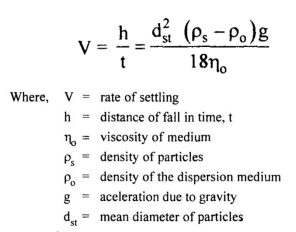part 8: MICROMERITICS
1/99
There's no tags or description
Looks like no tags are added yet.
Name | Mastery | Learn | Test | Matching | Spaced |
|---|
No study sessions yet.
100 Terms
Micromeritics
Science of small particles and the study of particle size distribution
Micrometer (micron)
Nanometer (nm)
The unit of particle size used most frequently is
Particle size and size distribution
Particle volume
Particle number
Particle shape
Particle surface area
The following are the five fundamental properties of powders from which other properties can be derived:
Packing geometry
Porosity
Density
Bulkiness
Flow property
Derived properties of powders
Optical Microscopy
Sieving Method
Sedimentation Method
Automated Particle Counter
Methods of Particle Size Determination
Optical Microscopy
Most popular and most accurate method of particle size determination
0.2 mcm - 100 mcm
Range of analysis of Optical Microscopy
SEM
TEM
These may be used in measuring very small particle size
TEM
May be used in measuring very small particle size, but 3D imaging is required
Direct observation of the shape and size of particles
Aggregation of particles can be detected
The field can be projected and a photograph can be taken
Easy to handle (Simple and Economic)
Advantages of Optical Microscopy
Diameter is obtained from only 2D of the particle (length and breadth); No estimation of depth (thickness)
Slow, tedious and time-consuming method
Disadvantages of Optical Microscopy
Feret’s diameter
Martin’s diameter
Projected area diameter
Expressions of Diameter
Feret’s diameter
Distance between pairs of parallel tangents to the projected outline of the particle in some fixed direction

Martin’s diameter
Diameter measured from the length of the particle at the point that divides a particle into two equal projected areas

Projected area diameter
Diameter of a circle having the same area as the projected area of the particle resting in stable position

Screening
Sieving method is also known as?
Sieving Method
Range of analysis: 50 um to 1500 um; although preferred size > 75 um
Range of analysis 40 um to 9500 um (Ansel Reference)
It consists of a series of standard sieves
National Bureau of Standards
Standard sieves are calibrated by
Mesh number or Mesh count
Number of square openings per linear inch
smaller openings
High mesh number =
large openings
Low mesh number =
Specially useful for weight distribution
Inexpensive
Very simple method
Advantages of Sieving Method
Sample should be dried every time
Induction of attrition during shaking – may cause reduction of particle size
Very small particles cannot be used because of surface and electrostatic forces
Disadvantages of Sieving Method
Sedimentation Method
Used for evaluation of suspensions, emulsions and determination of molecular weight of polymers
Range of analysis: 0.8 to 300 um
Based on Stoke’s law
Used for evaluation of suspensions, emulsions and determination of molecular

Stoke’s Law
Andreasen pipet or apparatus
Instrument used in Sedimentation Method
Coulter counter
Single particle optical counter (HIAC ROYCO particle counter)
Automated Particle Counter
Coulter counter
Principle: Electric resistance
↑Electric resistance = ↑Particle volume = ↑Particle size
Single particle optical counter (HIAC ROYCO particle counter)
Principle: Light blockage
↓ Transmitted light = ↑ Light blockage = ↑ Particle size
Their main use is to COUNT PARTICLES rather than size them
Stoke’s Law
What law is followed by SEDIMENTATION method
a. Boyle’s Law
b. Charle’s Law
c. Gay Lussac’s Law
d. Stoke’s Law
Void fraction
Porosity is also known as?
Porosity
Measure of the void volume in a powder material
Porosity
Represents the fraction of the powder volume that is occupied by the voids
Intraparticle space or voids
Space within the particle
Interparticle space or voids
Space between the particle
Closest or rhombohedral packing
Loosest or cubic packing
There are two ideal packing arrangements for the powder beds of uniform sized spheres
True volume (Vp)
Granule volume (Vg)
Bulk volume (Vb)
Types of Volume
True volume (Vp)
Volume of the solid particles EXCLUDING both INTRA and INTER PARTICULATE VOIDS
Granule volume (Vg)
True volume of particle with INTRAPARTICLE SPACE or VOIDS
Vg= Vp + Intraparticle space
Formula of Granule volume (Vg)
Vb= Vg + Interparticle space
Vb = Vp + Intraparticle + Interparticle space
Formula of Bulk volume (Vb)
ε Intraparticle
ε Interparticle
ε Total
Types of Porosity

ε Intraparticle

ε Interparticle

ε Total
Closest or rhombohedral packing
Bigger interparticle space
Loosest or cubic packing
Smaller interparticle space
Vg = 0.4mL
Vb = 2 mL
Interspace porosity = 80%
Total porosity = 85%
Compute for the following Granule volume, Bulk volume, Interspace porosity, Intraspace porosity and Total porosity.
Volume of particle=0.3 mL
Intraparticle space= 0.1 mL
Spaces between particles= 1.6 mL
note: refer to handouts for the solutions! 🙂
Density
Mass per unit volume
True density (ρ)
Granule density (ρg)
Bulk density (ρb)
Types of Density

Formula of True density (ρ)

Formula of Granule density (ρg)

Formula of Bulk density (ρb)
True density (ρ)
Type of Density that is determined using Helium Densiometer
Granule density (ρg)
Type of Density that is determined using Liquid Displacement Method
Bulk density (ρb)
Type of Density that is determined using Graduated Cylinder Method
Bulkiness or Specific Bulk Volume
What is the reciprocal of Bulk density?
Bulkiness or Specific Bulk Volume
Determines the size of container
Low particle size
High bulkiness = _____ particle size
Flow property
Plays an important role in the manufacturing of tablets or capsules
Particle size
Shape
Porosity and density
Surface texture
Surface force
Temperature
Flow properties depends on the:
High particle size
Smooth surface
High density
Low internal porosity
Low electrostatic charges
Spherical shape
Low temperature
Characteristics of powder with GOOD FLOWABILITY
Angle of Repose
Compressibility Index
Characterization of Powder Flow
Angle of Repose
Maximum angle possible between the surface of a pile powder and horizontal plane

Formula of Angle of Repose
< 25
Angle of Repose (degrees) of Excellent Flow
25-30
Angle of Repose (degrees) of Good Flow
30-40
Angle of Repose (degrees) of Poor Flow
> 40
Angle of Repose (degrees) of Very Poor Flow
Glidant
Addition of _________ is necessary to improve flow property
25-30
Angle of Repose (degrees) of Excellent Flow
31-35
Angle of Repose (degrees) of Good Flow
36-40
Angle of Repose (degrees) of Fair - aid not needed Flow
41-45
Angle of Repose (degrees) of Possible - may hang up Flow
46-55
Angle of Repose (degrees) of Poor - must agitate, vibrate Flow
> 66
Angle of Repose (degrees) of Very, very poor Flow
Compressibility
Ability to decrease in volume under pressure
Carr’s Compressibility Index
This index measures the tendency of a powder to consolidate

Formula of Carr’s Compressibility Index
Percent
Unit of Carr’s Compressibility Index

Formula of Hausner Ratio
Unitless
Unit of Hausner Ratio
≤ 10
Compressibility index (%) of Excellent Flow
11-15
Compressibility index (%) of Good Flow
16-20
Compressibility index (%) of Fair Flow
21-25
Compressibility index (%) of Passable Flow
26-31
Compressibility index (%) of Poor Flow
32-37
Compressibility index (%) of Very poor Flow
> 38
Compressibility index (%) of Very, very poor Flow
1.00-1.11
Hausner Ratio of Excellent Flow
1.12-1.18
Hausner Ratio of Good Flow
1.19-1.25
Hausner Ratio of Fair Flow
1.26-1.34
Hausner Ratio of Passable Flow
1.35-1.45
Hausner Ratio of Poor Flow
1.46-1.59
Hausner Ratio of Very poor Flow
> 1.60
Hausner Ratio of Very, very poor Flow
Carr’s Index = 23.08%
Hausner Ratio = 1.3
A powder was poured in a graduated cylinder and was noted to have a volume of 65 mL. It was allowed to compress by tapping the cylinder n the table counter. The initial volume was reduced by 15 mL.
Determine the Carrs index and Hausner Ratio
note: refer to handouts for solutions! 🙂
30.96°
A sample powder was made to flow from a funnel suspended @ a height of 20 cm. A powder cone of 1.2 cm from the surface was made as well as a spread of 4 cm in diameter.
Determine the angle repose of the powder
note: refer to handouts for solutions! 🙂
Inversely proportional
Relationship of Compressibility and Flowability
a. Directly proportional
b. Inversely proportional
c. NOTA
Angle of Repose
Simplest method to express flowability
a. Angle of Repose
b. Carrs Compressibility Index
c. Hausner Ratio
d. NOTA